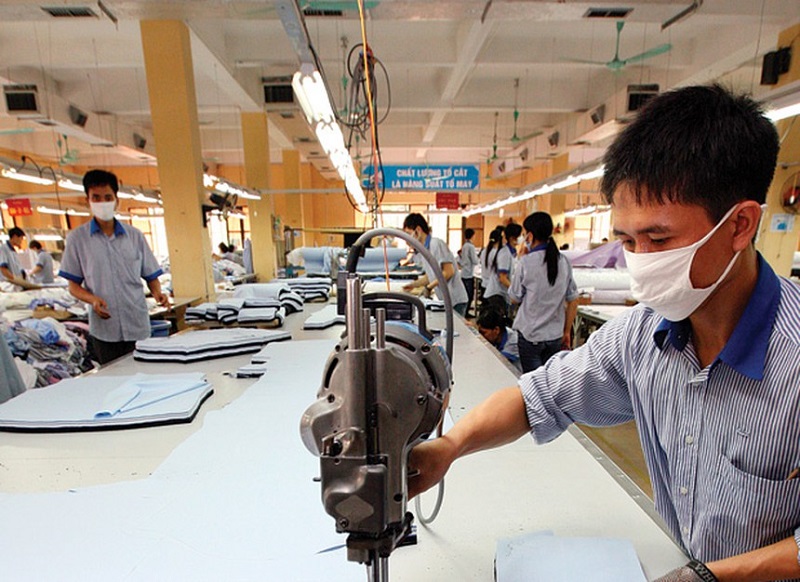
Labor supply is in short supply
As a labor-intensive industry, the textile and garment industry is employing about 2.5 million workers, but the income is not high, so since the outbreak of Covid-19, localities have had to implement isolation measures, people's lives have been reduced. The harder it is to work, many people have left to find other jobs.
A representative of the Vietnam National Textile and Garment Group (Vinatex) said that in order to retain workers, the Group has coordinated with trade unions to deploy many activities to support employees. The total amount supported by the Group from the 4th outbreak to the present time is over 26 billion VND.
Therefore, after being reopened from the beginning of October 2021, out of 65,000 employees, 56,000 people returned to work. "The above results are obtained because throughout the production process, the Group's businesses have been in close contact with employees, making efforts to support workers during the pandemic," a Vinatex representative emphasized. .
Not all enterprises have a high rate of returning workers like Vinatex. In general terms, there is an imbalance of labor supply and demand in some localities and industries. According to Deputy Minister of Labor, War Invalids and Social Affairs Le Van Thanh, in the first quarter of 2022, there will be a shortage of about 120,000 workers, mainly unskilled workers in the textile and garment industries, assembling electronic components, wood processing and manufacturing. Some industries were strongly affected and had to stop operating for a long time, such as tourism, education, etc.
In Ho Chi Minh City, about 98% of businesses have returned to production after the pandemic. Through the survey, businesses currently need more than 83,000 workers, but only 67,000 people are recruited, a shortage of about 16,000 workers. It is forecasted that from now until the end of the year, the city will need from 135,000 to 150,000 workers and is likely to continue to lack labor, especially in the peak months at the end of the year.
Labor market recovery
To restore the labor market, the Ministry of Labor - Invalids and Social Affairs has proposed and implemented many solutions such as focusing on ensuring basic social security for employees; improve the quality of human resources, train workers in skills to meet digital transformation; develop a labor market information system, strengthen the connection between labor supply and demand in order to effectively use human resources.
However, these solutions only partially meet the requirements of the labor market. Vinatex representative said that, in this period, instead of letting the labor market recover spontaneously, businesses compete for recruitment through paying extra wages or supporting return costs, it is necessary to " hands" of the State's management and labor management in localities in order to redeploy labor in the locality in the direction of "separation from agriculture, no separation from homeland".
“Localities need to accurately calculate the number of local workers who have returned from industrial zones and organize recruitment activities in the area so that workers do not have to migrate once. more", the representative of this business suggested.
According to Mr. Dao Quang Vinh, Director of the Institute of Labor and Social Sciences, the experience of developing countries in supporting businesses and workers to overcome the pandemic is to help workers overcome difficulties before the pandemic. eyes, more importantly, strengthen their confidence in the future, help them self-study to improve their professional level and skills.
To stabilize labor demand and maintain business operations, developing countries prioritize liquidity support for businesses and make adjustments to labor regulations. Among the liquidity policies, the most popular are tax breaks, credit guarantees, and loan repayment facilities.
Regarding labor regulations, Vinh said, countries support increasing work flexibility by allowing remote working, shortening working hours or other flexible work arrangements. Many countries have also made changes to support and treatment policies for workers, along with implementing measures to support entrepreneurs and businesses.
Particularly in Ho Chi Minh City, after a wave of foreign workers left, Mr. Duong Anh Duc, Vice Chairman of the City People's Committee said that he is focusing on training and fostering skills for workers to compensate for the remaining productivity. lack, as well as organize dialogues and negotiations to ensure harmonization of interests between parties in the labor market. In the long term, Ho Chi Minh City focuses on building a set of solutions to monitor, manage and forecast information about the labor market, including connecting intra-provincial and inter-provincial supply and demand with the data system.
Trong Tin
https://baodautu.vn/no-luc-phuc-hoi-thi-truong-lao-dong-sau-dich-d167641.html
baodautu